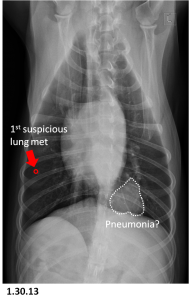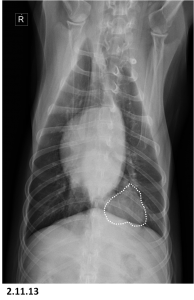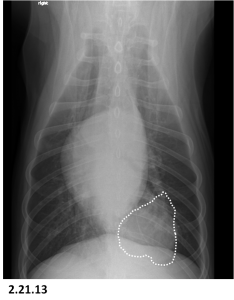Here is the update that we have so wanted to avoid writing. . .
As mentioned in a previous post, Jabba had an X-ray shortly before his 2 year ampuversary (Jan 4th) showing that against all odds, his lungs were still clear – save for a small nodule that had not changed size or appearance in the year since it had first become visible. We were beginning to think he may have actually beaten cancer!
A few weeks later, Jabba began showing signs of illness: he was drinking a lot, peeing in the house (more than usual) and he started developing eye boogers. At first, we weren’t too phased by this, as the symptoms were mild. However one night it became obvious Jabba was very sick: his eyes were red, his nose very warm, and he was hardly moving. We took him to the emergency vet fearing some kind of organ failure. We spent the bare minimum to rule out kidney failure (a $30 test), and planned on taking him to his family vet the next morning (in an interesting side note, the ER vet who saw Jabba was actually the former intern who first saw Jabba at NCSU 2 years ago, what a small world!). Here is the report from the ER:
Presenting Illness : Jabba Bear presented for evaluation of increased thirst and urination that was first noticed three
days ago, as well as lethargy, mild coughing and redness of his eyes with mucoid ocular discharge that was noticed
today. Jabba has a history of osteosarcoma of the left hind leg that was diagnosed approximately 2 years ago. Jabba
underwent an amputation and a course of chemotherapy. After the initial chemotherapy was completed, Jabba was
started on metronomic therapy consisting of cyclophosphamide, piroxicam and palladia. Since November of 2012, the
metronomic therapy was decreased to cyclophosphamide only. During the course of Jabba’s treatment he has had
several episodes of lower urinary tract signs which have been diagnosed as both sterile hemorrhagic cystitis and urinary
tract infections (based on culture). In November of 2011, Jabba completed the course of the OSA study he had been
enrolled in at NCSU CVM and radiographs taken at that time revealed a single possible nodule, repeat radiographs taken
(most recently in December of 2012) revealed that the nodule had not grown. Since Sunday, his owners report that his
water intake has been significantly increased and he has needed to go outside to urinate approximately every 2 hours
and has been producing a large amount of urine each time.Exam: Wt. 56.8lb, T 104.9, HR 144, RR 24, MM/CRT p<2
EENT – corneas clear OU; mild mucoid ocular discharge; mild scleral erythema; no nasal discharge; ears clean AU; no
abnormalities on limited oral examination; throat palpates normally
PLN – all peripheral lymph nodes palpate soft, small and symmetric
CVR – no murmurs or arrhythmias noted; femoral pulse strong; normal lung sounds ausculted over all fields
MSI – ambulatory x3 with no lameness noted; adequate, symmetrical muscling; no pain on palpation of long bones;
haircoat healthy; integument intact; no evidence of ectoparasites
GI/UG – no pain on abdominal palpation; no masses or organomegaly noted; neutered; no abnormalities on rectal
N – BAR, appropriate mentation; no CN or proprioceptive deficits noted; full neuro examination not performedAssessment:
1) Fever
2) PU/PD
3) Ocular discharge and rednessSWO – explained that while the PU/PD could not be easily tied to the other symptoms noted, it was probably the most
significant symptom and would be the initial focus of diagnostics. Discussed causes of PU/PD including renal
insufficiency, diabetes mellitis/insipidus, Cushing’s, Addison’s, pyelonephritis, hypercalcemia, hepatic insufficiency, etc..
Recommended CBC/Chem/L/UA and thoracic radiographs. Despite recheck thoracic radiographs being performed
relatively recently, new cough and possible pathology warrants rechecking. CBC/Chem/L/UA best way to determine
cause of PU/PD. Owners expressed financial constraints and inquired about waiting to have Jabba evaluated with
primary veterinarian in the morning; explained that without knowing the cause, I could not give them a prognosis.
Recommended checking BUN/Cre at a minimum to r/o renal insufficiency, if renal values are normal, would stillPresented: 01-29-13, 8:12p
recommend additional diagnostics, but other differentials would be less critical to treat immediately. Owners approved
BUN/Cre only.Treatment:
1) BUN/Cre – within normal limits (BUN 11, nl 7-27; Cre 1.3, nl 0.5-1.8)SWO – renal values within normal limits which makes primary renal insufficiency and other kidney problems such as
pyelonephritis unlikely. Cannot ruleout other causes of PU/PD as previously discussed. Other causes are still significant,
but renal insufficiency would be the most critical to treat immediately. Owners declined additional diagnostics and will
monitor at home overnight with a plan to follow up with their primary veterinarian in the morning. Discussed starting
antibiotics due to fever, would not recommend starting at this point without a better understanding of the cause if they
are planning to pursue additional diagnostics in the morning. Recommend monitoring at home overnight and bringing
back if any new developments or worsening symptoms, otherwise follow up with primary veterinarian in the morning
for additional diagnostics.Client Instructions:
As we discussed, there are numerous causes of increased thirst and urination and we cannot determine the cause of
Jabba Bear’s symptoms at this point without performing additional diagnostics. We checked Jabba’s renal values which
were normal and this rules out some of the more important causes, however, additional diagnostics to further evaluate
these causes was declined tonight in favor of monitoring at home and following up with your primary veterinarian in the
morning. As such, please keep a close eye on Jabba Bear over night and do not hesitate to call or bring him back to
AESFC if you have any concerns about how he is doing at home.Please follow up with your primary veterinarian tomorrow morning to discuss additional diagnostic and treatment
options.The treatment Jabba Bear received today was based on assessment of the presenting signs and diagnostic procedures
that were performed. Keep in mind that there can be complications that develop due to changes in the existing
condition or presence of underlying condition not apparent at the time of the treatment which can be severe or even
fatal.
So Jabba did not have kidney failure, and the next morning we took him to his family vet. His Dr. told us she suspected an infection, which would explain his fever and PU/PD (medical term for drinking and peeing a lot). An x-ray showed a mass in his lung, which the vet suspected was pneumonia. After all, his lungs were clear less than a month before, and this large, singular mass did not look like the typical presentation of osteosarcoma (many small mets). Jabba was prescribed antibiotics and we went home happy, thinking “at least he only has pneumonia!”

Once Jabba was diagnosed with pneumonia, we decided to stop his metronomic chemotherapy (9 mg cyclophosphamide every other day), in an effort to improve his ability to beat what we thought was an opportunistic infection. After all, Jabba-bear had been immunosuppressed for 2 years.
Unfortunately, after two weeks and several different antibiotics, Jabba’s fever and lethargy did not subside, his appetite became almost non existent, and he had lost a significant amount of weight. A second X-ray showed the mass had remained relatively stable. We should emphasize that Jabba-bear’s primary doctor did not suspect that the mass was metastatic lung cancer for several reasons:
(1) The apparent physical characteristics of the mass were less consistent with metastatic osteosarcoma (normally characterized by an abundance of small lesions throughout the lung, like the original suspicious lung met highlighted in the above X-ray, not one large well-defined mass in the caudal most portion of the lung).
(2) The mass appeared suddenly (sometime between 1.4.13 and 1.30.13). If this were metastatic disease, we would have expected to see at least a hint of it early in January. Whatever this was had gone from 0-60 in a blink of an eye.
(3) The mass had not changed much in size or shape in a week and a half (see the below X-ray). The only noticeable difference between the X-rays on 1.30.13 and 2.11.13 was that the boundaries of the mass were slightly thicker at the later time point, possibly reflecting the development of an abscess around the infection site. If this were metastatic lung cancer, it was clearly aggressive. . . meaning that we would have expected it to grow significantly in the time between these two images. And, it did not.

Because this supposed infection was antibiotic-resistant, we opted for a tracheal wash, which would capture whatever bacteria was causing the infection, and allow for tests to see which antibiotics would be effective against it. After 5 longs days, the results came back: there was no bacteria in Jabba’s lungs. At this point, Jabba’s fever had been hovering in the 104 range for over a week. It was time to consider the possibility that Jabba’s condition was more serious than we anticipated. Therefore, we were referred to a specialty vet: Carolina Veterinary Specialists (CVS).
Being an emergency and “referral only” vet, the attitude at CVS was a little different than what we were used to dealing with, but they came highly recommended. During our consultation, the doctor told us that she had reviewed Jabba’s X-rays (shown above) and was quite convinced that Jabba had lung cancer. The question was whether or not it was metastatic disease. This distinction is important. If it were a primary lung tumor (i.e., unrelated to Jabba-bear’s osteosarcoma) then there was a relatively good chance that removing the tumor would “cure” Jabba’s condition and that he could live a long(er) life. If, however, it were metastatic osteosarcoma, then there would be little that we could do besides love what little time we have left with him. Upon physical examination of Jabba, the vet confirmed another symptom that we had suspected but were unsure about: Jabba’s joints were swollen, which was a form of arthritis caused by systemic inflammation. The vet determined that the first step in diagnosing Jabba was to try and biopsy the mass in his lung using a needle and ultrasound. This was unsuccessful. Surgery to remove and biopsy the mass was presented as the only feasible option; or euthanasia. We were not given very much time to mull over the decision, being told in effect “this is very urgent.” At this point, the CVS vet was “highly suspicious” that the mass in Jabba’s lung was cancer, the logic being that cancer can cause an systemic immune response than can create fever and arthritis, etc. But, hearing the words of Jabba’s primary vet in our ears, we held out hope that this may in fact still be something else, and opted for surgery.
Before surgery, Jabba needed blood work to see if he was healthy enough to sustain the potentially invasive surgical procedure. We were informed that his blood tests showed evidence of liver failure, so again the option was more expensive tests, or euthanasia. An ultrasound of the liver showed no overt tumors present, so at the advice of the vet we had a bile acid tests done to examine liver function, and a joint tap to confirm the cause of his arthritis (I am still not sure the point of this test before surgery, but at this point we are in so deep, what the hell). Two days later the test results came back showing that Jabba’s liver was functioning well, so he was deemed fit to undergo surgery immediately. At this point he had been staying at the hospital for 3 nights, and receiving IV fluid to help lower his fever. The vet also put him on steroids to lower the fever, something she had been reluctant to do as if it was an infection, steroids would make it worse. The surgery was to be laproscopic (small incision and guided with a scope), but we agreed to allow them to make a larger incision and open the ribs if need be.
The next morning we got a call saying his fever was down in the 100’s, and he would be going to surgery soon, but also that the mass appeared larger upon x-ray. We should expect a call in about four hours. Two hours later we got a call from the vet, saying the mass was too large to remove without damaging the lung, and if we still wanted them to take some for biopsy. We were devastated, but told them to go ahead. An hour later, the surgeon (different from the vet) called and told us that, while he had gone for the larger incision and intercostal split, he had in fact removed the entire lobe of that lung, and gotten the entire mass. Suddenly hope came back, although the surgeon also informed us that there were suspicious looking lymph nodes near Jabba’s heart, which he also biopsied. The biopsy results would be back in a few days. We weren’t allowed to visit Jabba that night (we had been twice a day every day that week), but went to visit the next day and took him home the day after that (now Saturday, he had been at CVS since Monday).

The good news is that Jabba is doing well after surgery (now almost two weeks ago)! The bad news is that the biopsy results confirmed this was highly aggressive osteosarcoma, which was present in his lymph nodes. Here is the biopsy report:
Histopathology, Full Written Report Biopsy DESCRIPTION/MICROSCOPIC FINDINGS/COMMENTS:Microscopic Description:
Sections of a lung mass are examined on 3 slides. There is a
partially delineated neoplasm within pulmonary parenchyma composed of
ovoid to fusiform or occasionally stellate mesenchymal cells forming
broad interlacing bundles and trabecular arrays. The cells form thin
trabecula of osteoid and a few cell are entrapped with osteocytic
lacuna. The cells have pleomorphic hyperchromatic nuclei with coarse
chromatin stippling. There is a high mitotic rate. Several smaller
nodules are dispersed in the adjacent pulmonary parenchyma.
Sections of lymph node are examined. Nodal architecture is
effaced by the same type of neoplastic cells described above.Microscopic Findings:
Osteosarcoma, multifocal, lung, lymph node.Comment:
The osteosarcoma has metastasized to the lung and lymph node. The
prognosis for metastatic osteosarcoma is poor.

Wow, you guys have really been through the ringer lately. I am so sorry that Jabba Bear’s biopsy’s did not bring better news. Hopefully he still has some more fight left in him and you have more time to enjoy.
Thank you- we are optimistic! We have some gorgeous pictures of Jabba-bear post-lobectomy that we hope to post soon.
What tough news – so sorry you have to deal with all this and sending postive thoughts your way so you have as much time as possible with Jabba Bear.
What a brave boy! What great parents he has to be by his side this whole time, Jabba Bear is a miracle dog and I know he continues to feel loved and lucky! You are in our thoughts.
Sally and Happy Hannah
Thank you Sally and Happy Hannah! We appreciate your support.
Jabba and people, you are pretty special and wonderful to be there for eachother like this. Just remember that no matter what you decide, the only “right” decision is the one that’s made with love.